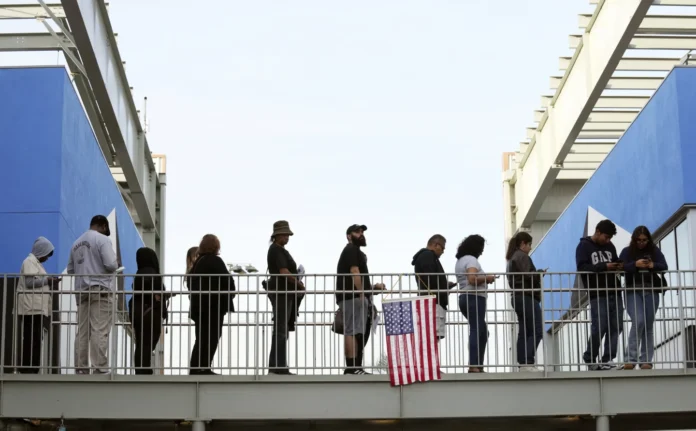The 2024 presidential election saw record turnout, reaching the unprecedented levels of the 2020 fight and defying long-held political wisdom that Republicans struggle to win races with large voter turnouts.
According to Associated Press election data, over 152 million ballots were cast in this year’s race between Republican Donald Trump, now president-elect, and Democrat Kamala Harris, vice president, with hundreds of thousands more still being counted in slower-counting states like California. When those ballots are entirely counted, the number of votes will be even closer to the 158 million cast in the 2020 presidential election, which was the largest turnout since women were granted the right to vote more than a century ago.
“Trump is great for voter turnout in both parties,” said political scientist Eitan Hersh of Tufts University.
The previous president’s triumph in both the Electoral College and the popular vote—Trump presently leads Harris by over 3 million votes nationwide—also violates the political notion that high-turnout elections boost Democrats rather than Republicans.
Trump expressed it in 2020, warning that a Democratic initiative to increase mail balloting would result in “levels of voting that, if you ever agreed to it, you’d never have a Republican elected in this country again.” That warning came as Trump began to spread conspiracy theories about mail voting during the coronavirus pandemic, which he later used to falsely claim his 2020 defeat was due to fraud.
As the battle over turnout became a prominent aspect of political discourse, a wave of new laws was enacted, imposing rules and scaling back forms of voting in Republican-controlled states, and expanding mail voting in Democratic-led ones. Such measures often have a minor influence on voting but have sparked accusations of voter suppression from Democrats and fraud from Republicans.
“It’s such an embarrassing story for proponents on both sides, because it’s so obviously wrong,” Hersh told the crowd.
Though both sides are sure to continue to disagree on how elections should be run, Trump’s high turnout victory may reduce the urgency of that debate.
“Now I think, you just won the popular vote, I think it’ll quiet down,” said Patrick Ruffini, a Republican data analyst and pollster who has long argued that his party can win a high-turnout election with a diverse electorate.
According to experts, turnout in the seven key swing states was greater than in the rest of the country.
“This was a campaign in seven states much more so than previous elections have felt like,” according to Ruffini.
While the rest of the country changed dramatically since 2020, when Democrat Joe Biden won the popular vote by 7 million, or 4.5 percentage points, the outcome in swing states was closer. The turnout story also differed. Turnout decreased from 2020 in noncompetitive states such as Illinois, which recorded more than 500,000 less votes than in the previous presidential election, and Ohio, which reported more than 300,000 fewer votes.
Meanwhile, the number of votes cast exceeded that of 2020 in the battleground states of Georgia, Michigan, Nevada, North Carolina, Pennsylvania, and Wisconsin, all of which Trump won. Arizona’s turnout was roughly identical to four years earlier, as the state began to tally votes.
Harris even reached or surpassed Biden’s vote totals in Georgia, Nevada, North Carolina, and Wisconsin, and turnout has greatly beyond that of the 2016 presidential election, when Trump defeated Democrat Hillary Clinton with 135.6 million votes. The challenge for Democrats is that Trump performed better in the battleground states than four years ago.
“The Harris campaign did a pretty good job of getting voters who wouldn’t have come out,” said Tom Bonier, a Democratic data analyst. “She got her voters out. “Trump received more.”
Among those Trump turnout successes was Jasmine Perez, 26, a first-time voter who voted for Trump at the Las Vegas Raiders Stadium.
“I’m a Christian and he really aligns with a lot of my values as a Christian in America, and I like that he openly promotes Christianity in America,” Perez told the audience.
Diego Zubek, 27, supported for Trump in 2016 but did not vote in 2020 because he expected Trump to win handily. He voted for Donald Trump this year.
“I wasn’t going to let that happen again,” Zubek explained.
Reaching out to voters like Perez and Zubek was an important element of the GOP plan, as it encouraged early and mail voting after Republicans had mostly abandoned them in the previous two years owing to Trump’s falsehoods about vote fraud. Conservatives launched major voter registration and get-out-the-vote efforts aimed at infrequent voters, a population that many operatives had long assumed would not vote for the GOP.
This year, more than half of all votes were cast before Election Day, according to AP tracking of the advanced vote.
During the campaign, Andrew Kolvet, a spokesman for Turning Point Action, a conservative group that ran a get-out-the-vote campaign with over 1,000 workers in multiple battleground states, cited Stacey Abrams, a former Democratic candidate for Georgia governor, as an inspiration for his organization. Abrams’ achievement in organizing Black voters and other demographics in her home state who were less likely to vote paved the stage for Biden’s 2020 victory there.
“We saw that Trump has this amazing reservoir of low-propensity conservatives who just needed a little coaxing,” Kolvet said in an interview Friday. “They didn’t think their vote mattered, and their No. 1 pushback was they didn’t understand, really, how to vote.”
Kolvet agreed that conservatives have long assumed that high attendance did not benefit them, but said that has changed in the Trump era: “Our ideas are more popular,” he said.
What happens next in Washington will determine if it continues.
“It’s going to be up to conservatives to make good on those campaign promises,” Kolvet told reporters.
